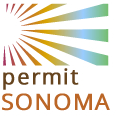Pre-Reviewed Accessory Dwelling Unit Program

Introducing ADU Ready
The County of Sonoma’s ADU Ready program encourages the construction of detached accessory dwelling units (ADUs) through the use of pre-reviewed ADU plans. This program aligns with Government Code Section 65852.27 established with Assembly Bill 1332 and supports housing goals outlined in the Sonoma County General Plan. The program aims to simplify the design and permitting process, making it faster, easier, and more affordable.
How It Works
Licensed professionals can submit ADU designs to Permit Sonoma for pre-review. Approved designs will be listed in the ADU Design Gallery. Homeowners looking to build an ADU can browse this gallery and contact a listed vendor to obtain a plan package.
Applicants can work with a professional or follow owner-builder requirements to integrate the selected ADU plan into a project-specific package for submission with a building permit application. Applicants are responsible for licensing fees and any plan use restrictions set by vendors.
Once a complete building permit application is submitted and initial fees are paid, the application is reviewed within 30 days for zoning consistency, fire code compliance, and site-specific requirements. Revisions may be requested if needed. If all requirements are met, final fees are assessed, and the building permit is issued. Construction can then begin, and upon passing all inspections, a certificate of occupancy will be granted.
- Project Applicants: Individuals or entities planning to build an ADU using pre-reviewed plans. They may work with a design team to integrate the plans with their site.
- Plan Vendors: Licensed professionals who submit plans for inclusion in the ADU Ready Design Gallery. These include:
- Designers of stick-built ADUs
- Manufacturers of factory-built or modular ADUs
Applicability
ADU Ready streamlining applies to new construction detached ADUs using unmodified pre-reviewed plans. Modifications to these plans may require additional fees and processing time. Vendors in the Pre-Reviewed ADU Design Gallery may also provide inspiration or custom design services for those opting out of the program.
Coastal Parcels
Parcels in the coastal zone (CC zoning designation) may use the ADU Ready program but require land use permit approval before submitting a building permit application. Refer to Sec. 26C-325.1 of the Sonoma County Municipal Code for coastal zoning standards. In the coastal zone, ADUs are referred to as “second dwelling units.”
- Use Permit (UPE): Required for coastal parcels zoned LIA (Land Intensive Agriculture) or LEA (Land Extensive Agriculture).
- Zoning Permit (ZPE): Required for coastal parcels zoned DA (Diverse Agriculture), RRD (Rural Resources & Development), RR (Rural Residential), AR (Agricultural Residential), R1 (Low-Density Residential), R2 (Medium-Density Residential), and R3 (High-Density Residential).
Getting Started with ADU Ready
- Review the PJR-149 Preliminary ADU Checklist.
-
Use the Parcel Search Tool to navigate the checklist based on your site.
- Stick Built Designs: Applications using pre-reviewed stock plans with an "STK" reference number should include this number in their application.
- Factory-Built Housing and Manufactured Homes: Regulated by the California Department of Housing and Community Development (HCD) and the U.S. Department of Housing and Urban Development (HUD).
- Applications for factory-built ADUs should include the corresponding HCD insignia number.
- Applications for manufactured homes should include the corresponding HCD placard number.
- A checklist of submittal requirements and procedures is coming soon. For details, contact Isabella Wotring.
- Visit the Permit Center to meet with staff from each division.
Interested in Submitting Plans for the Gallery?
ADU Ready Program Benefits
Project Applicant Benefits
- Less Time, Effort, and Money. From designing to permitting, pre-reviewed plans save time and work.
- Designing: Integrating a pre-reviewed ADU plan into a site plan can lessen the load of compliance measures, plan drawings, and details the applicant and their design team have to focus on. This not only saves time but can reduce the overall cost of the project design.
- Permitting: The timeline for review of an ADU building permit is normally 60 days. Under the ADU Ready program, this is cut in half to just 30 days. Since certain standards are already met through the pre-reviewed plans, the building division has less items to review. This means lower fees may be charged for projects using pre-reviewed plans.
- More Certainty. Though the applicant will still need to mindful of certain site and project-specific standards when choosing and integrating pre-reviewed ADU plans with their site, they can breathe knowing the plan details of the ADU itself have already been checked for code compliance. So long as proper due diligence is done before applying for a building permit, applicants using pre-reviewed ADU plans are less likely to be held up by unmet objective standards.
Plan Vendors Benefits
- Income. Once plans are approved as pre-reviewed, licensing fees for the same pre-reviewed ADU package may be sold repeatedly until the end of the code cycle.
- Client Reach. Vendors’ plans and contact information will be listed in our online gallery to be perused by potential ADU project applicants. Applicants may reach out to purchase a pre-reviewed ADU plan package, but they may also be looking for help with a custom ADU project outside of the ADU Ready program.
Partially Streamlined Review
Using pre-reviewed ADU plans reduces the load on the applicant and their team by providing a base template for the ADU itself. However, individual site conditions and constraints must still be addressed by the applicant, including, but not limited to, foundation, wastewater, water, fire-safe standards, and zoning requirements. As such, plans listed in the Design Gallery are referred to as “pre-reviewed” rather than “pre-approved”.

 Translate
Translate